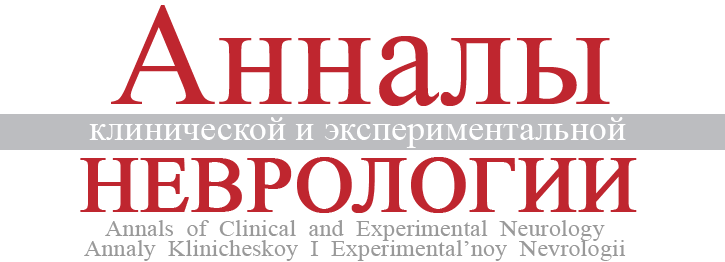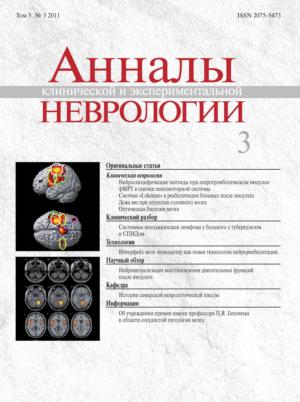Интерфейс мозг-компьютер как новая технология нейрореабилитации
- Авторы: Мокиенко O.A.1, Черникова Л.А.2, Фролов A.A.1
-
Учреждения:
- Институт высшей нервной деятельности и нейрофизиологии РАН
- ФГБНУ «Научный центр неврологии»
- Выпуск: Том 5, № 3 (2011)
- Страницы: 46-52
- Раздел: Технологии
- URL: https://www.annaly-nevrologii.com/journal/pathID/article/view/297
- DOI: https://doi.org/10.17816/psaic297
- ID: 297
Цитировать
Полный текст
Аннотация
Интерфейсы мозг-компьютер (ИМК) – это инвазивные или неинвазивные технологии, позволяющие преобразовывать некоторые нейрофизиологические сигналы в команды, адресованные внешнему техническому устройству или компьютеру. В последние годы данные технологии активно разрабатывают для применения в реабилитации пациентов с неврологическими заболеваниями. Такие интерфейсы могут служить средством взаимодействия с окружающим миром для больных с синдромом locked-in. С помощью интерфейсов пациенты с двигательными нарушениями могли бы управлять роботизированными протезами, инвалидной коляской и прочими внешними техническими устройствами. Применение интерфейсов с биологической обратной связью может способствовать правильной реорганизации коры головного мозга при ее повреждении. Согласно данным проведенных исследований, пациенты с неврологическими нарушениями способны овладевать технологией интерфейс мозг-компьютер. Тем не менее, для дальнейшей оценки потенциальной роли технологии ИМК в реабилитации пациентов с неврологическими заболеваниями необходимы более крупные контролируемые клинические исследования.
Ключевые слова
Об авторах
O. A. Мокиенко
Институт высшей нервной деятельности и нейрофизиологии РАН
Email: Lesya.md@yandex.ru
Россия, Москва
Людмила Александровна Черникова
ФГБНУ «Научный центр неврологии»
Email: Lesya.md@yandex.ru
Россия, Москва
A. A. Фролов
Институт высшей нервной деятельности и нейрофизиологии РАН
Автор, ответственный за переписку.
Email: Lesya.md@yandex.ru
Россия, Москва
Список литературы
- Ang K.K., Guan C., Chua K.S. et al. Clinical study of neurorehabilitation in stroke using EEG-based motor imagery brain-computer interface with robotic feedback. Conf. Proc. IEEE Eng. Med. Biol. Soc. 2010; 2010: 5549–5552.
- Ang K.K., Guan C., Chua K.S. et al. A clinical evaluation of noninvasive motor imagery-based brain-computer interface in stroke. Conf. Proc. IEEE Eng. Med. Biol. Soc. 2008; 2008: 4178–4181.
- Ball T., Kern M., Mutschler I. et al. Signal quality of simultaneously recorded invasive and non-invasive EEG. Neuroimage. 2009 Jul. 1; 46 (3): 708–716.
- Birbaumer N., Ghanayim N., Hinterberger T. et al. A spelling device for the paralysed. Nature 1999 Mar. 25; 398 (6725): 297–298.
- Birbaumer N., Hinterberger T., Kubler A., Neumann N. The thoughttranslation device (TTD): neurobehavioral mechanisms and clinical outcome. IEEE Trans. Neural Syst. Rehabil. Eng. 2003 Jun.; 11 (2): 120–123.
- Birbaumer N., Ramos Murguialday A., Weber C., Montoya P. Neurofeedback and brain-computer interface clinical applications. Int. Rev. Neurobiol. 2009; 86: 107–117.
- Blankertz B., Dornhege G., Krauledat M. et al. The non-invasive Berlin Brain-Computer Interface: fast acquisition of effective performance in untrained subjects. Neuroimage 2007 Aug. 15; 37 (2): 539–550.
- Bradberry T.J., Gentili R.J., Contreras-Vidal J.L. Reconstructing three-dimensional hand movements from noninvasive electroencephalographic signals. J. Neurosci. 2010 Mar. 3; 30 (9): 3432–3437.
- Broetz D., Braun C., Weber C. et al. Combination of brain-computer interface training and goal-directed physical therapy in chronic stroke: a case report. Neurorehabil. Neural. Repair. 2010 Sep.; 24 (7): 674–679.
- Buch E., Weber C., Cohen L.G. et al. Think to move: a neuromagnetic brain-computer interface (BCI) system for chronic stroke. Stroke 2008 Mar.; 39 (3): 910–917.
- Calautti C., Naccarato M., Jones P.S. et al. The relationship between motor deficit and hemisphere activation balance after stroke: A 3T fMRI study. Neuroimage 2007 Jan. 1; 34 (1): 322–331.
- Caria A., Veit R., Sitaram R. et al. Regulation of anterior insular cortex activity using real-time fMRI. Neuroimage 2007 Apr. 15; 35 (3): 1238–1246.
- Caria A., Weber C., Brotz D. et al. Chronic stroke recovery after combined BCI training and physiotherapy: A case report. Psychophysiology 2011 Apr.; 48 (4): 578–582.
- Carmena J.M., Lebedev M.A., Crist R.E. et al. Learning to control a brain-machine interface for reaching and grasping by primates. PLoS Biol. 2003 Nov.; 1 (2): E42.
- Daly J.J., Cheng R., Rogers J. et al. Feasibility of a new application of noninvasive Brain Computer Interface (BCI): a case study of training for recovery of volitional motor control after stroke. J. Neurol. Phys. Ther. 2009 Dec.; 33 (4): 203–211.
- deCharms R.C., Maeda F., Glover G.H. et al. Control over brain activation and pain learned by using real-time functional MRI. Proc. Natl. Acad. Sci. USA 2005 Dec. 20; 102 (51): 18626–18631.
- Donoghue J.P., Nurmikko A., Black M., Hochberg L.R. Assistive technology and robotic control using motor cortex ensemble-based neural interface systems in humans with tetraplegia. J. Physiol. 2007 Mar. 15; 579 (3): 603–611.
- Fabiano G.A., Chacko A., Pelham W.E. et al. A comparison of behavioral parent training programs for fathers of children with attentiondeficit/ hyperactivity disorder. Behav. Ther. 2009 Jun.; 40 (2): 190–204.
- Farwell L.A., Donchin E. Talking off the top of your head: toward a mental prosthesis utilizing event-related brain potentials. Electroencephalogr. Clin. Neurophysiol. 1988 Dec.; 70 (6): 510–523.
- Freeman W.J., Rogers L.J., Holmes M.D., Silbergeld D.L. Spatial spectral analysis of human electrocorticograms including the alpha and gamma bands. J. Neurosci. Methods. 2000 Feb. 15; 95 (2): 111–121.
- Gastaut H., Terzian H., Gastaut Y. [Study of a little electroencephalographic activity: rolandic arched rhythm]. Mars Med. 1952; 89 (6): 296–310.
- Hochberg L.R., Serruya M.D., Friehs G.M. et al. Neuronal ensemble control of prosthetic devices by a human with tetraplegia. Nature 2006 Jul. 13; 442 (7099): 164–171.
- Kennedy P.R., Bakay R.A. Restoration of neural output from a paralyzed patient by a direct brain connection. Neuroreport. 1998 Jun. 1; 9 (8): 1707–1711.
- Kotchoubey B., Strehl U., Uhlmann C. et al. Modification of slow cortical potentials in patients with refractory epilepsy: a controlled outcome study. Epilepsia 2001 Mar.; 42 (3): 406–416.
- Kubler A., Kotchoubey B., Kaiser J. et al. Brain-computer communication: unlocking the locked in. Psychol. Bull. 2001 May; 127 (3): 358–375.
- Kubler A., Nijboer F., Mellinger J. et al. Patients with ALS can use sensorimotor rhythms to operate a brain-computer interface. Neurology 2005 May 24; 64 (10): 1775–1777.
- Lebedev M.A., Nicolelis M.A. Brain-machine interfaces: past, present and future. Trends Neurosci. 2006 Sep.; 29 (9): 536–546.
- Lenhardt A., Kaper M., Ritter H.J. An adaptive P300-based online brain-computer interface. IEEE Trans Neural. Syst. Rehabil. Eng. 2008 Apr.; 16 (2): 121–130
- Leuthardt E.C., Schalk G., Wolpaw J.R. et al. A brain-computer interface using electrocorticographic signals in humans. J. Neural. Eng. 2004 Jun.; 1 (2): 63–71.
- Logothetis N.K., Pauls J., Augath M. et al. Neurophysiological investigation of the basis of the fMRI signal. Nature 2001 Jul. 12; 412 (6843): 150–157.
- Lotze M., Grodd W., Birbaumer N. et al. Does use of a myoelectric prosthesis prevent cortical reorganization and phantom limb pain? Nat. Neurosci. 1999 Jun.; 2 (6): 501–502.
- McFarland D.J., Krusienski D.J., Sarnacki W.A. et al. Emulation of computer mouse control with a noninvasive brain-computer interface. J. Neural. Eng. 2008 Jun.; 5 (2): 101–110.
- McFarland D.J., Miner L.A., Vaughan T.M., Wolpaw J.R. Mu and beta rhythm topographies during motor imagery and actual movements. Brain Topogr. 2000 Spring; 12 (3): 177–186.
- Mellinger J., Schalk G., Braun C. et al. An MEG-based brain-computer interface (BCI).
- Meng F., Tong K-yR., Chan S-tP. et al. BCI-FES training system design and implementation for rehabilitation of stroke patients. Proceedings of the International Joint Conference on Neural Networks; June; Hong Kong, China: IEEE World Congress on Computational Intelligence; 2008: 4103–4106.
- Mohapp A., Scherer R., Keinrath C. et al. Single-trial EEG classification of executed and imagined hand movements in hemiparetic stroke patients. 3rd International BCI Workshop and Training Course; Graz 2006: 80–81.
- Nagaoka T., Sakatani K., Awano T. et al. Development of a new rehabilitation system based on a brain-computer interface using nearinfrared spectroscopy. Adv. Exp. Med. Biol. 2010; 662: 497–503.
- Perelmouter J., Birbaumer N. A binary spelling interface with random errors. IEEE Trans Rehabil. Eng. 2000 Jun.; 8(2): 227–232.
- Pfurtscheller G., Aranibar A. Evaluation of event-related desynchronization (ERD) preceding and following voluntary self-paced movement. Electroencephalogr. Clin. Neurophysiol. 1979 Feb.; 46 (2): 138–146.
- Pfurtscheller G., Graimann B., Huggins J.E., Levine S.P. Brain-computer communication based on the dynamics of brain oscillations. (Suppl.: Clin Neurophysiol.) 2004; 57: 583–591.
- Pfurtscheller G., Guger C., Muller G. et al.Brain oscillations control hand orthosis in a tetraplegic. Neurosci. Lett. 2000 Oct. 13; 292 (3): 211–214.
- Pfurtscheller G., Muller G.R., Pfurtscheller J. et al. ‘Thought’—control of functional electrical stimulation to restore hand grasp in a patient with tetraplegia. Neurosci. Lett. 2003 Nov. 6; 351 (1): 33–36.
- Platz T., Kim I.H., Engel U. et al. Brain activation pattern as assessed with multi-modal EEG analysis predict motor recovery among stroke patients with mild arm paresis who receive the Arm Ability Training. Restor Neurol. Neurosci. 2002; 20 (1–2): 21–35.
- Prasad G., Herman P., Coyle D. et al. Applying a brain-computer interface to support motor imagery practice in people with stroke for upper limb recovery: a feasibility study. J. Neuroeng. Rehabil. 2010; 7 (1): 60.
- Rockstroh B., Birbaumer N., Elbert T., Lutzenberger W. Operant control of EEG and event-related and slow brain potentials. Biofeedback Self Regul. 1984 Jun.; 9 (2): 139–160.
- Seifert A.R., Lubar J.F. Reduction of epileptic seizures through EEG biofeedback training. Biol Psychol. 1975 Nov.; 3 (3): 157–184.
- Serruya M.D., Hatsopoulos N.G., Paninski L., Fellows M.R. et al. Instant neural control of a movement signal. Nature 2002 Mar. 14; 416 (6877): 141–142.
- Sitaram R., Caria A., Birbaumer N. Hemodynamic brain-computer interfaces for communication and rehabilitation. Neural. Netw. 2009 Nov.; 22 (9): 1320–1328.
- Staba R.J., Wilson C.L., Bragin A., Fried I., Engel J., Jr. Quantitative analysis of high-frequency oscillations (80-500 Hz) recorded in human epileptic hippocampus and entorhinal cortex. J. Neurophysiol. 2002 Oct.; 88 (4): 1743–1752.
- Strehl U., Leins U., Goth G., Klinger C., Hinterberger T., Birbaumer N. Self-regulation of slow cortical potentials: a new treatment for children with attention-deficit/hyperactivity disorder. Pediatrics 2006 Nov.;118 (5): 1530–1540.
- Taylor D.M., Tillery S.I., Schwartz A.B. Direct cortical control of 3D neuroprosthetic devices. Science 2002 Jun. 7; 296 (5574): 1829–1832.
- Velliste M., Perel S., Spalding M.C. et al. Cortical control of a prosthetic arm for self-feeding. Nature 2008 Jun. 19; 453 (7198): 1098–1101.
- Vidal J.J. Toward direct brain-computer communication. Annu Rev. Biophys. Bioeng. 1973; 2: 157–180.
- Waldert S., Preissl H., Demandt E. et al. Hand movement direction decoded from MEG and EEG. J. Neurosci. 2008 Jan. 23; 28 (4): 1000–1008.
- Ward N.S., Cohen L.G. Mechanisms underlying recovery of motor function after stroke. Arch. Neurol 2004 Dec.; 61 (12): 1844–1848.
- Weiskopf N., Veit R., Erb M. et al. Physiological self-regulation of regional brain activity using real-time functional magnetic resonance imaging (fMRI): methodology and exemplary data. Neuroimage 2003 Jul.; 19 (3): 577–586.
- Wolpaw J.R. Brain-computer interfaces as new brain output pathways. J. Physiol. 2007 Mar. 15; 579 (Pt 3): 613–619.
- Wolpaw J.R., Birbaumer N., McFarland D.J. et al. Brain-computer interfaces for communication and control. Clin. Neurophysiol. 2002 Jun.; 113 (6): 767–791.
- 59. Wolpaw J.R., McFarland D.J. Control of a two-dimensional movement signal by a noninvasive brain-computer interface in humans. Proc. Natl. Acad. Sci. USA 2004 Dec. 21; 101 (51): 17849–17854.
- Yoo S.S., Fairneny T., Chen N.K. et al. Brain-computer interface using fMRI: spatial navigation by thoughts. Neuroreport. 2004 Jul. 19; 15 (10): 1591–1595.
Дополнительные файлы








